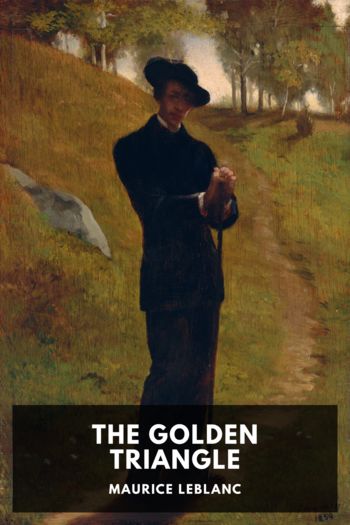The Secret of Sarek by Maurice Leblanc (best e ink reader for manga .txt) 📕

- Author: Maurice Leblanc
Book online «The Secret of Sarek by Maurice Leblanc (best e ink reader for manga .txt) 📕». Author Maurice Leblanc
“And the chief of chiefs, with a solemn gesture, drew the yellow cloth and revealed a block of granite in the shape of a slab about two yards by one, granular in appearance and dark in colour, with a few glittering scales gleaming in its substance.
“There was a single shout raised by the crowd of men and women; and all, with outstretched arms, fell flat on their faces in the dust.
“Then the chief of chiefs took up a metal sceptre with a jewelled handle, which lay on the block of granite, brandished it on high and spoke:
“ ‘The all-powerful staff shall not leave my hand until the miraculous stone is in a place of safety. The all-powerful staff is born of the miraculous stone. It also contains the fire of heaven, which gives life or death. While the miraculous stone was the tomb of my forefathers, the all-powerful staff never left their hands on days of disaster or of victory. May the fire of heaven lead us! May the Sun-god light our way!’
“He spoke: and the whole tribe set out upon its journey.”
Don Luis struck an attitude and repeated, in a self-satisfied tone:
“He spoke: and the whole tribe set out upon its journey.”
Patrice Belval was greatly amused; and Stéphane, infected by his hilarity, began to feel more cheerful. But Don Luis now addressed his remarks to them:
“There’s nothing to laugh at! All this is very serious. It’s not a story for children who believe in conjuring tricks and sleight of hand, but a real history, all the details of which will, as you shall see, give rise to precise, natural and, in a sense, scientific explanations. Yes, ladies and gentlemen, scientific: I am not afraid of the word. We are here on scientific ground; and Vorski himself will regret his cynical merriment.”
Don Luis took a second sip of water and continued:
“For weeks and months the tribe followed the course of the Elbe; and one evening, on the stroke of half-past nine, reached the seaboard, in the country which afterwards became the country of the Frisians. It remained there for weeks and months, without finding the requisite security. It therefore determined upon a fresh exodus.
“This time it was a naval exodus. Thirty boats put out to sea—observe this number thirty, which was that of the families composing the tribe—and for weeks and months they wandered from shore to shore, settling first in Scandinavia, next among the Saxons, driven off, putting to sea again and continuing their voyage. And I assure you it was really a strange, moving, impressive sight to see this vagrant tribe dragging in its wake the tombstone of its kings and seeking a safe, inaccessible and final refuge in which to conceal its idol, protect it from the attack of its enemies, celebrate its worship and employ it to consolidate the tribal power.
“The last stage was Ireland; and it was here that, one day, after they had dwelt in the green isle for half a century or perhaps a century, after their manners had acquired a certain softening by contact with nations which were already less barbarous, the grandson or great-grandson of the great chief, himself a great chief, received one of the emissaries whom he maintained in the neighbouring countries. This one came from the continent. He had discovered the miraculous refuge. It was an almost unapproachable island, protected by thirty rocks and having thirty granite monuments to guard it.
“Thirty! The fateful number! It was an obvious summons and command from the mysterious deities. The thirty galleys were launched once more and the expedition set forth.
“It succeeded. They took the island by assault. The natives they simply exterminated. The tribe settled down; and the tombstone of the Kings of Bohemia was installed … in the very place which it occupies today and which I showed to our friend Vorski. Here I must interpolate a few historical data of the greatest significance. I will be brief.”
Adopting a professorial tone, Don Luis explained:
“The island of Sarek, like all France and all the western part of Europe, had been inhabited for thousands of years by a race known as the Liguri, the direct descendants of the cave-dwellers part of whose manners and customs they had retained. They were mighty builders, those Liguri, who, in the neolithic period, perhaps under the influence of the great civilizations of the east, had erected their huge blocks of granite and built their colossal funeral chambers.
“It was here that our tribe found and made great use of a system of caves and natural crypts adapted by the patient hand of man and of a cluster of enormous monuments which struck the mystic and superstitious imagination of the Celts.
“We find therefore that, after the first or wandering phase, there begins for the God-Stone a period of rest and worship which we will call the Druidical period. It lasted for a thousand or fifteen hundred years. The tribe became mingled with the neighbouring tribes and probably lived under the protection of some Breton king. But, little by little, the ascendancy had passed from the chiefs to the priests; and these priests, that is to say, the Druids, assumed an authority which increased in the course of the generations that followed.
“They owed this authority, beyond all doubt, to the miraculous stone. True, they were the priests of a religion accepted by all and also the instructors of Gallic childhood (it seems certain, incidentally, that the cells under the Black Heath were those of a Druid convent, or rather a sort of university);





Comments (0)